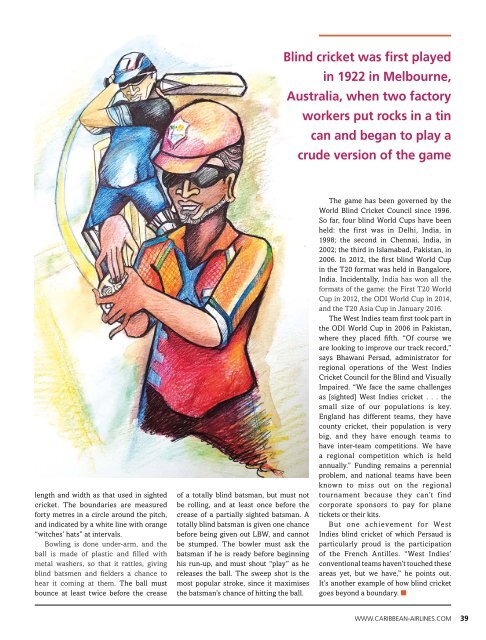Caribbean Beat — January/February 2017 (#143)
A calendar of events; music, film, and book reviews; travel features; people profiles, and much more.
A calendar of events; music, film, and book reviews; travel features; people profiles, and much more.
Create successful ePaper yourself
Turn your PDF publications into a flip-book with our unique Google optimized e-Paper software.
Blind cricket was first played<br />
in 1922 in Melbourne,<br />
Australia, when two factory<br />
workers put rocks in a tin<br />
can and began to play a<br />
crude version of the game<br />
length and width as that used in sighted<br />
cricket. The boundaries are measured<br />
forty metres in a circle around the pitch,<br />
and indicated by a white line with orange<br />
“witches’ hats” at intervals.<br />
Bowling is done under-arm, and the<br />
ball is made of plastic and filled with<br />
metal washers, so that it rattles, giving<br />
blind batsmen and fielders a chance to<br />
hear it coming at them. The ball must<br />
bounce at least twice before the crease<br />
of a totally blind batsman, but must not<br />
be rolling, and at least once before the<br />
crease of a partially sighted batsman. A<br />
totally blind batsman is given one chance<br />
before being given out LBW, and cannot<br />
be stumped. The bowler must ask the<br />
batsman if he is ready before beginning<br />
his run-up, and must shout “play” as he<br />
releases the ball. The sweep shot is the<br />
most popular stroke, since it maximises<br />
the batsman’s chance of hitting the ball.<br />
The game has been governed by the<br />
World Blind Cricket Council since 1996.<br />
So far, four blind World Cups have been<br />
held: the first was in Delhi, India, in<br />
1998; the second in Chennai, India, in<br />
2002; the third in Islamabad, Pakistan, in<br />
2006. In 2012, the first blind World Cup<br />
in the T20 format was held in Bangalore,<br />
India. Incidentally, India has won all the<br />
formats of the game: the First T20 World<br />
Cup in 2012, the ODI World Cup in 2014,<br />
and the T20 Asia Cup in <strong>January</strong> 2016.<br />
The West Indies team first took part in<br />
the ODI World Cup in 2006 in Pakistan,<br />
where they placed fifth. “Of course we<br />
are looking to improve our track record,”<br />
says Bhawani Persad, administrator for<br />
regional operations of the West Indies<br />
Cricket Council for the Blind and Visually<br />
Impaired. “We face the same challenges<br />
as [sighted] West Indies cricket . . . the<br />
small size of our populations is key.<br />
England has different teams, they have<br />
county cricket, their population is very<br />
big, and they have enough teams to<br />
have inter-team competitions. We have<br />
a regional competition which is held<br />
annually.” Funding remains a perennial<br />
problem, and national teams have been<br />
known to miss out on the regional<br />
tournament because they can’t find<br />
corporate sponsors to pay for plane<br />
tickets or their kits.<br />
But one achievement for West<br />
Indies blind cricket of which Persaud is<br />
particularly proud is the participation<br />
of the French Antilles. “West Indies’<br />
conventional teams haven’t touched these<br />
areas yet, but we have,” he points out.<br />
It’s another example of how blind cricket<br />
goes beyond a boundary. n<br />
WWW.CARIBBEAN-AIRLINES.COM 39


















